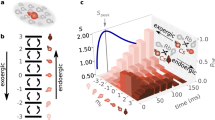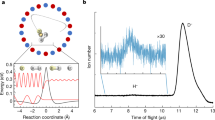Abstract
An exponential decay law is the universal hallmark of unstable systems and is observed in all fields of science. This law is not, however, fully consistent with quantum mechanics and deviations from exponential decay have been predicted for short as well as long times1,2,3,4,5,6,7,8. Such deviations have not hitherto been observed experimentally. Here we present experimental evidence for short-time deviation from exponential decay in a quantum tunnelling experiment. Our system consists of ultra-cold sodium atoms that are trapped in an accelerating periodic optical potential created by a standing wave of light. Atoms can escape the wells by quantum tunnelling, and the number that remain can be measured as a function of interaction time for a fixed value of the well depth and acceleration. We observe that for short times the survival probability is initially constant before developing the characteristics of exponential decay. The conceptual simplicity of the experiment enables a detailed comparison with theoretical predictions.
This is a preview of subscription content, access via your institution
Access options
Subscribe to this journal
Receive 51 print issues and online access
$199.00 per year
only $3.90 per issue
Buy this article
- Purchase on Springer Link
- Instant access to full article PDF
Prices may be subject to local taxes which are calculated during checkout




Similar content being viewed by others
References
Khalfin, L. A. Contribution to the decay theory of a quasi-stationary state. JETP 6, 1053–1063 (1958).
Winter, R. G. Evolution of a quasi-stationary state. Phys. Rev. 123, 1503–1507 (1961).
Fonda, L., Ghirardi, G. C. & Rimini, A. Decay theory of unstable quantum systems. Rep. Prog. Phys. 41, 587–631 (1978).
Ballentine, L. E. Quantum Mechanics (Prentice Hall, Englewood Cliffs, NJ, (1990)).
Greenland, P. T. Seeking non-exponential decay. Nature 335, 298 (1988).
Chiu, C. B., Sudarshan, E. C. G. & Misra, B. Time evolution of unstable quantum states and a resolution of Zeno's paradox. Phys. Rev. D 16, 520–529 (1977).
Sudarshan, E. C. G., Chiu, C. B. & Bhamathi, G. in Advances in Chemical Physics Vol. XCIX(eds Prigogine, I. & Rice, S. A.) 121–209 (Wiley, New York, (1997)).
Petrosky, T. & Prigogine, I. in Advances in Chemical Physics Vol. XCIX(eds Prigogine, I. & Rice, S. A.) 1–120 (Wiley, New York, (1997)).
Kazantsev, A. P., Surdutovich, G. I. & Yakovlev, V. P. Mechanical Action of Light on Atoms (World Scientific, Singapore, (1990)).
Niu, Q., Zhao, X., Georgakis, G. A. & Raizen, M. G. Atomic Landau-Zener tunneling and Wannier-Stark ladders in optical potential. Phys. Rev. Lett. 76, 4504–4507 (1996).
Wilkinson, S. R., Bharucha, C. F., Madison, K. W., Niu, Q. & Raizen, M. G. Observation of atomic Wannier-Stark ladders in an accelerating optical potential. Phys. Rev. Lett. 76, 4512–4515 (1996).
Ben Dahan, M., Peik, E., Reichel, J., Castin, Y. & Salomon, C. Bloch oscillations of atoms in an optical potential. Phys. Rev. Lett. 76, 4508–4511 (1996).
Bharucha, C. F. et al. Observation of atomic tunneling in an accelerating optical potential. Phys. Rev. A 55, R857–R860 (1997).
Cohen-Tannoudji, C. in Fundamental Systems in Quantum Optics (eds Dalibard, J., Raimond, J. M. & Zinn-Justin, J.) 1–164 (Elsevier, Amsterdam, (1992)).
Moore, F. L., Robinson, J. C., Bharucha, C., Williams, P. E. & Raizen, M. G. Observation of dynamical localization in atomic momentum transfer: a new testing ground for quantum chaos. Phys. Rev. Lett. 73, 2974–2977 (1994).
Acknowledgements
M.G.R. was supported by the US Office of Naval Research, the Robert A. Welch Foundation, and the US National Science Foundation; B.S. was supported by the US National Science Foundation; Q.N. was supported by the Robert A. Welch Foundation.
Author information
Authors and Affiliations
Corresponding author
Rights and permissions
About this article
Cite this article
Wilkinson, S., Bharucha, C., Fischer, M. et al. Experimental evidence for non-exponential decay in quantum tunnelling. Nature 387, 575–577 (1997). https://doi.org/10.1038/42418
Received:
Accepted:
Issue Date:
DOI: https://doi.org/10.1038/42418
This article is cited by
-
Irreversible and quantum thermodynamic considerations on the quantum zeno effect
Scientific Reports (2023)
-
Non-Abelian effects in dissipative photonic topological lattices
Nature Communications (2023)
-
Decays of Unstable Quantum Systems
International Journal of Theoretical Physics (2019)
-
Temperature dependence of long coherence times of oxide charge qubits
Scientific Reports (2018)
-
Effect of different filling tendencies on the spatial quantum Zeno effect
Scientific Reports (2018)
Comments
By submitting a comment you agree to abide by our Terms and Community Guidelines. If you find something abusive or that does not comply with our terms or guidelines please flag it as inappropriate.



